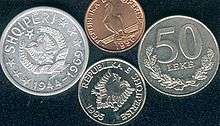Albanian lek
The lek (Albanian: Leku Shqiptar; plural lekë) (sign: L; code: ALL) is the official currency of Albania. It was formerly subdivided into 100 qindarka (singular qindarkë), but qindarka are no longer issued.
| Albanian lek | |||||
|---|---|---|---|---|---|
| Leku Shqiptar (Albanian) | |||||
| |||||
| ISO 4217 | |||||
| Code | ALL | ||||
| Number | 008 | ||||
| Exponent | 2 | ||||
| Denominations | |||||
| Subunit | |||||
| 1⁄100 | Qindarka | ||||
| Plural | Lekë | ||||
| Symbol | L | ||||
| Banknotes | |||||
| Freq. used | 200 L, 500 L, 1000 L, 2000 L, 5000 L | ||||
| Coins | |||||
| Freq. used | 5 L, 10 L, 20 L, 50 L, 100 L | ||||
| Rarely used | 1 lek | ||||
| Demographics | |||||
| Date of introduction | 16 February 1926 | ||||
| User(s) | |||||
| Issuance | |||||
| Central bank | Bank of Albania | ||||
| Website | www | ||||
| Valuation | |||||
| Inflation | 2.1% | ||||
| Source | The World Factbook, 2009 est. | ||||
History
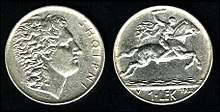
The lek was introduced as the first Albanian currency in February 1926.[1]
Before then, Albania was a country without a currency, adhering to a gold standard for the fixation of commercial values. Before the First World War the Ottoman Turkish piastre was in full circulation, but following the military occupation of the country by various continental powers the gold franc (Franc Germinal) was adopted as the monetary unit. In 1923 Italian paper circulated at Shkodër, Durrës, Vlorë, and Gjirokastër, and the Greek drachma at Korçë, the values of which varied according to locality and the prevailing rates of exchange as compared with gold.[2]
Etymology
The lek was named after Alexander the Great,[3] whose name is often shortened to Leka in Albanian.[4] Alexander's portrait appeared on the obverse of the 1 lek coin, while the reverse showed him on his horse.
The name qindarkë comes from the Albanian qind, meaning one hundred. The word is thus similar in formation to centime, cent, etc.
Franga
Between 1926 and 1939 the name Franga was used for Albanian gold currency worth five Albanian Lekë for use in international transactions.[5] A similar alternate name Belga was used for units of five Belgian francs.
Coins
First lek
In 1926, bronze coins were introduced in denominations of 5 and 10 qindar leku, together with nickel 1⁄4, 1⁄2 and 1 lek, and silver 1, 2 and 5 franga ar. The obverse of the franga coins depicts Amet Zogu. In 1935, bronze 1 and 2 qindar ar were issued, equal in value to the 5 and 10 qindar leku respectively. This coin series depicted distinct neoclassical motifs, said to have been influenced by the Italian king Victor Emmanuel III who was known to have been a coin collector. These coins depict the mint marks "R", "V" or "L", indicating Rome, Vienna or London.
Under the direction of Benito Mussolini, Italy invaded and occupied Albania and issued a new series of coins in 1939 in denominations 0.20, 0.50, 1 and 2 lek in stainless steel, and silver 5, and 10 lek were introduced, with the silver coins only issued that year. Aluminium-bronze 0.05 and 0.10 lek were introduced in 1940. A fixed exchange with the Italian lira at 1:6.25 was established. These coins were issued until 1941 and bear the portrait of Italian King Victor Emmanuel III on the obverse and the Albanian eagle with fasces on the reverse.
In 1947, shortly after the Communist Party took power, older coins were withdrawn from circulation and a new coinage was introduced, consisting of zinc 1⁄2, 1, 2 and 5 lekë. These all depicted the socialist national crest. This coinage was again minted in 1957 and used until the currency reform of 1965.
Second lek
In 1965, the old lek banknotes and coins were exchanged into new ones, 10:1 (the amount allowed for exchange was limited).
Aluminium coins (dated 1964) were introduced in denominations of 5, 10, 20 and 50 qindar and 1 lek. All coins show the socialist state emblem.
In 1969, a second series of aluminum 5, 10, 20, 50 qindar and 1 lek coins was released commemorating the 1944 liberation from fascism. The three smallest denominations remained similar in design to the 1964 series but depicted "1944-1969" on the obverse. The 50 qindarka and lek coins showed patriotic and military images.
In 1988, a third redesign of aluminum 5, 10, 20, 50 qindarka and 1 lek coins was released. The 50 qindarka and 1 lek coins were problematically identical in size, weight, and appearance, so aluminum-bronze 1 lek coins with the inscription "Republika Popullore Socialiste e Shqipërisë" were released later that year for better identification. In 1989, a cupro-nickel 2 lekë coin was introduced.
All three of these coin series remained in circulation during and shortly after the 1991 revolution.
Third lek
In 1995 and 1996, new coins were introduced in denominations of 1, 5, 10, 20 and 50 lekë, with a bimetallic 100 lekë added in 2000. The 1 lek coin is not practically in use.
| Coins of the lek (1995–present)[6] | ||||||||
|---|---|---|---|---|---|---|---|---|
| Obverse | Reverse | Value | Technical parameters | Description | ||||
| Diameter | Mass | Composition | Edge | Obverse | Reverse | |||
| 1 lek | 18.1 mm | 3 g | bronze (1996), Copper-plated Steel (2008-2013) | Smooth | A pelican in the center, "Republika e Shqipërisë", year |
Nominal value, branches artistically carved in the form of a crown. | ||
 |
 |
5 lekë | 20 mm | 3.12 g | Nickel-plated Steel | Eagle from the Flag of Albania, "Republika e Shqipërisë", year | ||
 |
 |
10 lekë | 21.25 mm | 3.6 g | aluminum-bronze (1996-2000), Brass-plated Steel (2009-...) | Reeded | Berat Castle, "Republika e Shqipërisë", year | |
 |
 |
20 lekë | 23 mm | 4.6 g | aluminum-bronze (1996-2000), Brass-plated Steel (2012-2016) | Reeded | A liburne ship,"Republika e Shqipërisë", year of issue. | |
 |
 |
50 lekë | 24.25 mm | 5.5 g | Copper-nickel (1996-2000) | Portrait of the Illyrian King Gentius."Republika e Shqipërisë", year | ||
 |
 |
100 lekë | 24.75 mm | 6.7 g | Bi-Metallic Aluminium-bronze center in Copper-nickel ring | Portrait of the Illyrian Queen Teuta,"Republika e Shqipërisë", year | ||
| These images are to scale at 2.5 pixels per millimetre. For table standards, see the coin specification table. | ||||||||
Commemorative coins
In 2001, 100 and 200 lekë were issued under the theme of Albania's integration into the EU and 50, 100, and 200 lekë under the 500th anniversary of the Statue of David. In 2002, 50 lekë and 100 lekë were issued for the 90th Anniversary of the Independence of Albania and 20 lekë under the Albanian Antiquity theme. In 2003, 50 lekë was issued in memory of the 100th anniversary of the death of Jeronim De Rada. In 2004, 50 lekë was issued under the Albanian Antiquity theme depicting traditional costumes of Albania and the ancient Dea. In 2005, 50 lekë were issued for the 85th anniversary of the proclamation of Tirana as capital and the theme of traditional costumes of Albania.
Banknotes
First lek
In 1926, the National Bank of Albania (Banka Kombëtare e Shqipnis) introduced notes in denominations of 1, 5, 20 and 100 franka ari. In 1939, notes were issued denominated as 5 and 20 franga. These were followed in 1944 with notes for 2, 5 and 10 lekë and 100 franga.
In 1945, the People's Bank of Albania (Banka e Shtetit Shqiptar) issued overprints on National Bank notes for 10 lekë, 20 and 100 franga. Regular notes were also issued in 1945 in denominations of 1, 5, 20, 100 and 500 franga. In 1947, the lek was adopted as the main denominations, with notes issued for 10, 50, 100, 500 and 1000 lekë.
| 1947 series | |||||||||||||||||||||||||||||||||||||||||||||
|---|---|---|---|---|---|---|---|---|---|---|---|---|---|---|---|---|---|---|---|---|---|---|---|---|---|---|---|---|---|---|---|---|---|---|---|---|---|---|---|---|---|---|---|---|---|
| Obverse | Reverse | Value | |||||||||||||||||||||||||||||||||||||||||||
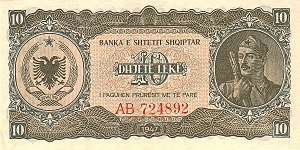 |
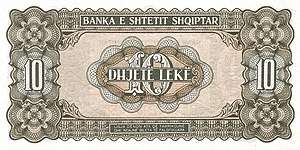 |
10 lekë | |||||||||||||||||||||||||||||||||||||||||||
 |
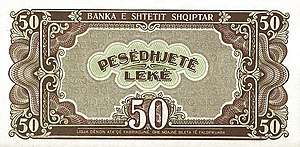 |
50 lekë | |||||||||||||||||||||||||||||||||||||||||||
 |
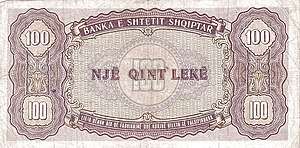 |
100 lekë | |||||||||||||||||||||||||||||||||||||||||||
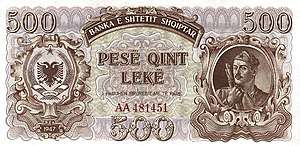 |
 |
500 lekë | |||||||||||||||||||||||||||||||||||||||||||
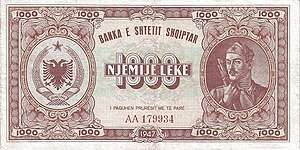 |
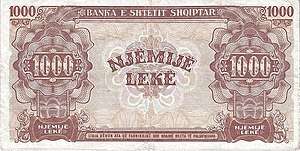 |
1,000 lekë | |||||||||||||||||||||||||||||||||||||||||||
| 1949 and 1957 series | |||||||||||||||||||||||||||||||||||||||||||||
| Obverse | Reverse | Value | |||||||||||||||||||||||||||||||||||||||||||
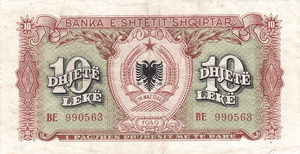 |
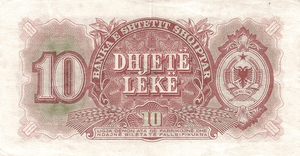 |
10 lekë | |||||||||||||||||||||||||||||||||||||||||||
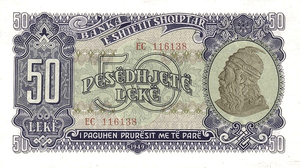 |
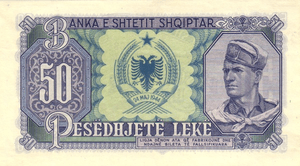 |
50 lekë | |||||||||||||||||||||||||||||||||||||||||||
 |
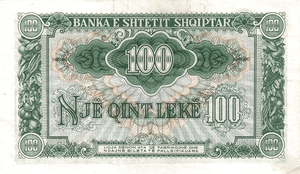 |
100 lekë | |||||||||||||||||||||||||||||||||||||||||||
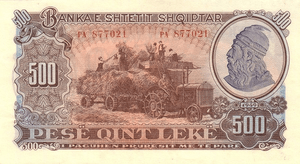 |
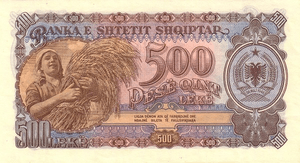 |
500 lekë | |||||||||||||||||||||||||||||||||||||||||||
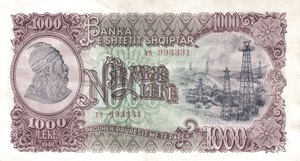 |
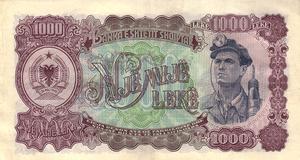 |
1,000 lekë | |||||||||||||||||||||||||||||||||||||||||||
Second lek
In 1965, notes (dated 1964) were introduced by the Banka e Shtetit Shqiptar in denominations of 1, 3, 5, 10, 25, 50 and 100 lekë. A second series of notes was issued in 1976 when the country changed its name to the People's Socialist Republic.
| 1964 and 1976 series | |||||
|---|---|---|---|---|---|
| Obverse | Reverse | Value | Colour | Obverse | Reverse |
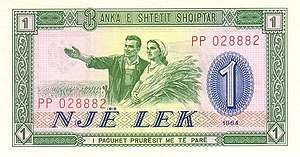 |
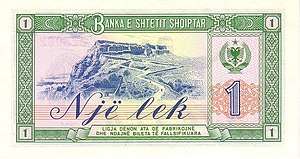 |
1 lek | Green | Peasant couple with wheat | Castle of Shkodër |
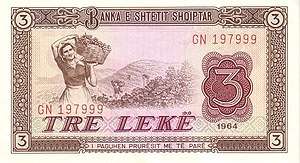 |
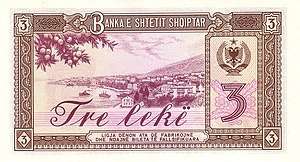 |
3 lekë | Brown | Woman carrying basket of fruit | Vlora |
 |
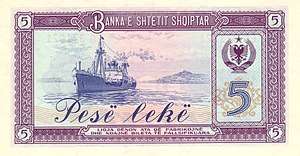 |
5 lekë | Purple | Steam train and truck | Ship |
 |
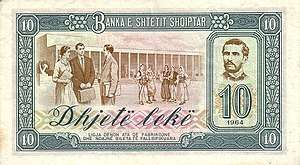 |
10 lekë | Green | Woman working in a textile mill | Bureaucrats and peasants socializing outside the Palace of Culture, Naim Frashëri |
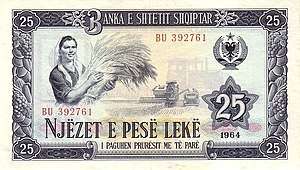 |
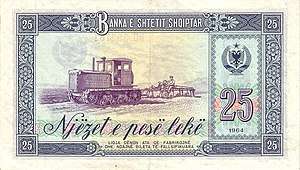 |
25 lekë | Dark blue | Woman with wheat, combine harvesting | Mechanized ploughing |
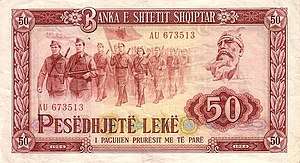 |
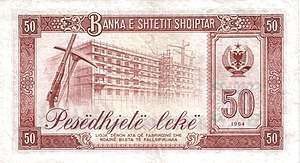 |
50 lekë | Red | Army on parade, Skanderbeg | Rifle, pickaxe, apartment block under construction |
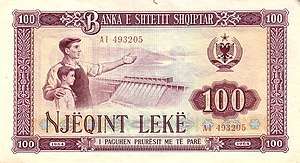 |
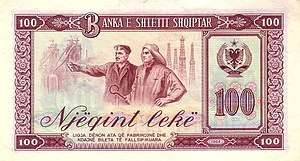 |
100 lekë | Scarlet | Man showing his son a new hydroelectric dam | Steelworker with oil worker, gesturing grandly, steelworks and oil wells in background |
1992 series
| 1992 Series | ||||||
|---|---|---|---|---|---|---|
| Image | Value | Dimensions | Main Colour | Description | ||
| Obverse | Reverse | Obverse | Reverse | |||
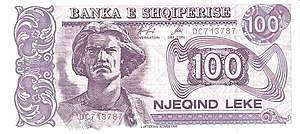 |
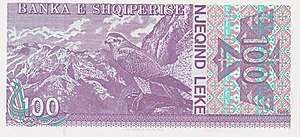 |
100 lekë | 154 × 72 mm | Violet | National fighter | Falcon and mountains |
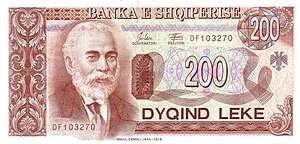 |
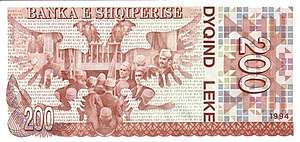 |
200 lekë | 162 × 78 mm | Brown | Ismail Qemali | Coat of arms of Albania, declaration of independence of Albania |
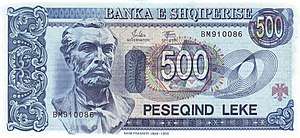 |
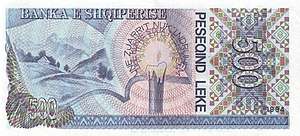 |
500 lekë | 170 × 78 mm | Blue | Naim Frashëri | Poetry of Frashëri |
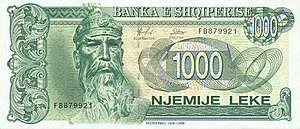 |
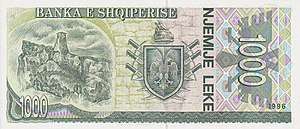 |
1000 lekë | 178 × 78 mm | Green | Skanderbeg | Krujë Castle |
1996 series
On 11 July 1997, a new series of banknotes dated 1996 was introduced.[7]
Notes dated 1996 were printed by De La Rue in the United Kingdom.
| 1996 Series[8] | ||||||
|---|---|---|---|---|---|---|
| Image | Value | Dimensions | Main Colour | Description | ||
| Obverse | Reverse | Obverse | Reverse | |||
 |
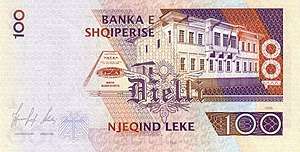 |
100 lekë | 130 × 66 mm | Purple | Fan S. Noli | First Albanian Parliament building |
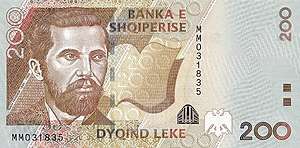 |
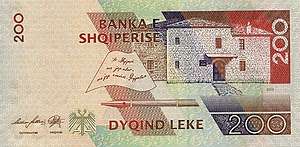 |
200 lekë | 138 × 69mm | Orange | Naim Frashëri | Birthplace of Frashëri |
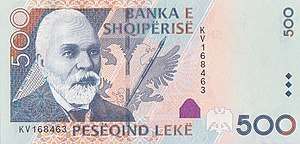 |
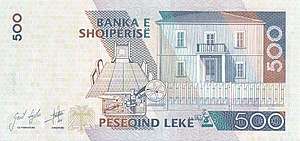 |
500 lekë | 145 × 68 mm | Blue | Ismail Qemali | Vlorë independence building |
 |
 |
1000 lekë | 151 × 72 mm | Green | Pjetër Bogdani | Church of Vau |
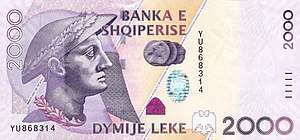 |
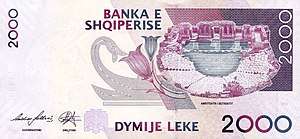 |
2000 lekë | 160 x 72 mm | Purple | King Gent (Gentius); three ancient coins | Amphitheatre at Butrinto (near Saranda), yellow gentian (Gentiana lutea) |
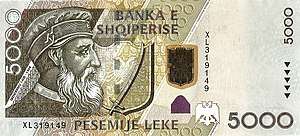 |
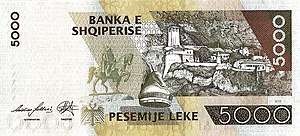 |
5000 lekë | 160 × 72 mm | Brown | Skanderbeg | Krujë Castle |
2019-2022 series
The Bank of Albania in 2019 unveiled a new series of banknotes, featuring the same themes on both the front and back side of the notes, improved security features, and a change in material for the 200 lekë banknote, now issued as a polymer banknote. This series has also introduced a new denomination, 10,000 lekë, its highest denominated banknote issued for general circulation. The first two denominations issued for this series, the 200 and 5,000 lekë banknote were issued for circulation on 30 September 2019, with the 1,000 and 10,000 lekë banknotes to be issued in 2020, the 2,000 lekë banknote in 2021 and the 500 lekë banknote in 2022.
Exchange rates
| Current ALL exchange rates | |
|---|---|
| From Google Finance: | AUD CAD CHF EUR GBP HKD JPY USD |
| From Yahoo! Finance: | AUD CAD CHF EUR GBP HKD JPY USD |
| From XE.com: | AUD CAD CHF EUR GBP HKD JPY USD |
| From OANDA: | AUD CAD CHF EUR GBP HKD JPY USD |
| From fxtop.com: | AUD CAD CHF EUR GBP HKD JPY USD |
See also
- Economy of Albania
References
- Bank of Albania. Available at:"Archived copy". Archived from the original on 25 October 2014. Retrieved 26 November 2014.CS1 maint: archived copy as title (link)
- Trade Information Bulletin, Numbers 79 to 118, 1923
- Leslie Alan Dunkling; Adrian Room (1 January 1990). The Guinness Book of Money. Guinness Publishing. p. 67. ISBN 978-0-85112-399-8.
...the lek takes its name from the abbreviated name of Alexander the Great, who was associated with this region of Europe...
- Howard M. Berlin (2006). World Monetary Units: An Historical Dictionary, Country By Country. McFarland & Company Incorporated Pub. p. 8. ISBN 978-0-7864-2080-3.
...The current monetary unit, the lek, is derived from the abbreviation of the Albanian spelling of Alexander the Great...
- "Albanian Gold Coins - Albania". taxfreegold.co.uk. Archived from the original on 5 December 2013.
- https://www.bankofalbania.org/Currency/Coins_in_circulation/
- Bank of Albania. Available at: http://www.bankofalbania.org Archived 3 December 2008 at the Wayback Machine
- Bank of Albania. Available at: "Archived copy". Archived from the original on 3 June 2013. Retrieved 19 May 2012.CS1 maint: archived copy as title (link)
- Krause, Chester L.; Clifford Mishler (1991). Standard Catalog of World Coins: 1801–1991 (18th ed.). Krause Publications. ISBN 0873411501.
- Pick, Albert (1994). Standard Catalog of World Paper Money: General Issues. Colin R. Bruce II and Neil Shafer (editors) (7th ed.). Krause Publications. ISBN 0-87341-207-9.
| Wikimedia Commons has media related to Money of Albania. |
External links
- Albanian Lek: Full detailed Catalog of Banknotes of Albania since 1926
- All Albanian coins and additional information
- Coin Types from Albania Lists, pictures, and values of Albanian coin types
- Albanian Banknotes
- All series of Banknotes, "Archived copy". Archived from the original on 29 June 2011. Retrieved 2 January 2011.CS1 maint: archived copy as title (link)
- Historical and current banknotes of Albania
